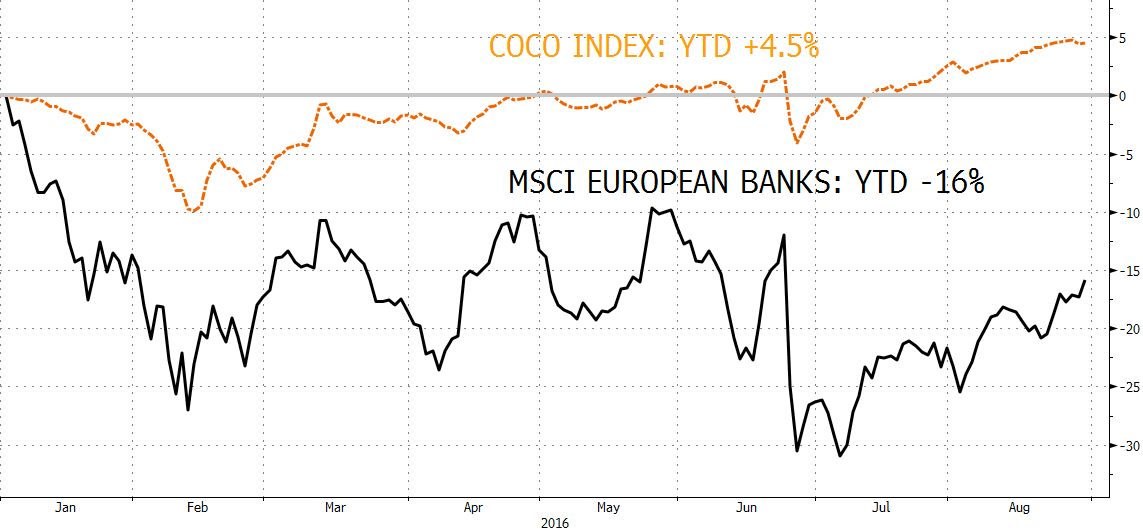Where is the truth?

Regulators on both sides of the Atlantic agreed to introduce Contingent Convertible bonds (“CoCos”) following the big financial crisis as a way to strengthen banks’ capital levels and transfer the risk of a bank failing from governments to bondholders, thus preventing taxpayer bailouts. CoCos are securities issued by banks that will absorb losses by automatically converting to equity when the capital of the issuing bank falls below a certain pre-specified level (trigger event), hence building a loss-absorbing financial cushions during periods of financial stress. Since 2009, banks have issued about $380 billion of CoCos, of which $120 billion by European banks; to date, no CoCo has missed a coupon payment or experienced a trigger event.
However, CoCos hit the headlines with the market turmoil at the beginning of the year as debt sold by Europe’s biggest issuers tumbled on concern struggling lenders – including Deutsche Bank – might have trouble making interest payments. Concerns over the real intrinsic risk of these securities were raised by many investors.
This month’s chart shows the performance of European banking sector versus the CoCo Index so far this year. Bank’s equities are trading at -16%, including a 15% recovery following the Brexit vote. On the opposite side, CoCos have fully recovered from the February loss and are up 4.5% year to date.
Therefore the question is: where is the truth? Is the CoCos’ recovery a consequence of investors’ search for yield at any cost and are now overpriced, or is the banks’ equity undervalued, offering an attractive entry level?
Unfortunately the answer is not unique since the divergence in performance of bank’s equity and CoCo has been driven by different factors. On the equity side, the explanation relies on the current ultra-low rates environment and negative interest policies (i), whereas the recent regulatory developments (ii) as well as the result of the last ECB stress tests (iii) have reassured investors about these bonds and the banks’ capital level.
- EU bank revenues continue to come under pressure as rates stay and are expected to remain low following the economic uncertainties triggered by the UK’s Brexit vote, leading to further expected reduction in banks’ net interest income. Furthermore, while the introduction of zero policy rates appears to have had a positive impact on credit creation, there is no evidence that negative policy rates helped credit creation in Denmark and Switzerland.
- The steep sell-off of CoCos in the first quarter was provoked by confusion over when exactly diminishing levels of capital would require a lender to halt coupon payments. Since then, regulators have sought to reduce uncertainty:
- First, the ECB agreed to include a portion of Pillar 2 in the CBR (“combined buffer requirement”, a measure of the total Common Equity Tier 1 capital), resulting in increased protection for investors from coupon deferrals;
- Second, the European Commission has proposed boosting protections for holders of CoCos, allowing banks to pay stock dividends and bonuses to employees only if coupons are paid in full. The coupon-protection plan is currently under study at the ECB.
- Finally, the last ECB’s stress test highlights that EU main banks have built up a substantial amount of capital since the financial crisis and are considerably more stable than at the time of the last stress test in 2014. Indeed, an average Capital Tier 1 ratio of 13.2% provides a significant buffer against the adverse scenario stress test assumptions (which include a recession, weak domestic demand, declining property prices and widening of sovereign credit spreads, among others
As a result of the ECB and European Commission interventions, CoCos have experienced a nice and gradual recovery that might continue going forward. For comparison, the CoCo Index is priced with an spread to worst of 443bp with an average rating of BB1, compared to a less attractive European High Yield Index’s spread of 395bp with an average rating two notches lower (BB3). As a practical example, Rabobank 5.5% 01/22/2049 (BBB-, Common Equity Tier 1 at 13.5% and trigger event at 5.13%) is trading with a yield of 5% if called in June 2016 and almost 6% if not called; with the same rating, Repsol 3.63% 10/07/2021 is yielding 0.45%!
Concerns about the European banks’ ability to generate profits will continue to weight on the bank’s stocks as well as the potential, unintended consequences of negative rates policies. On the other side, the willingness of regulators to move forward in the definition of the rules and mechanism of CoCos will support the investors’ appetite for juicy yields.